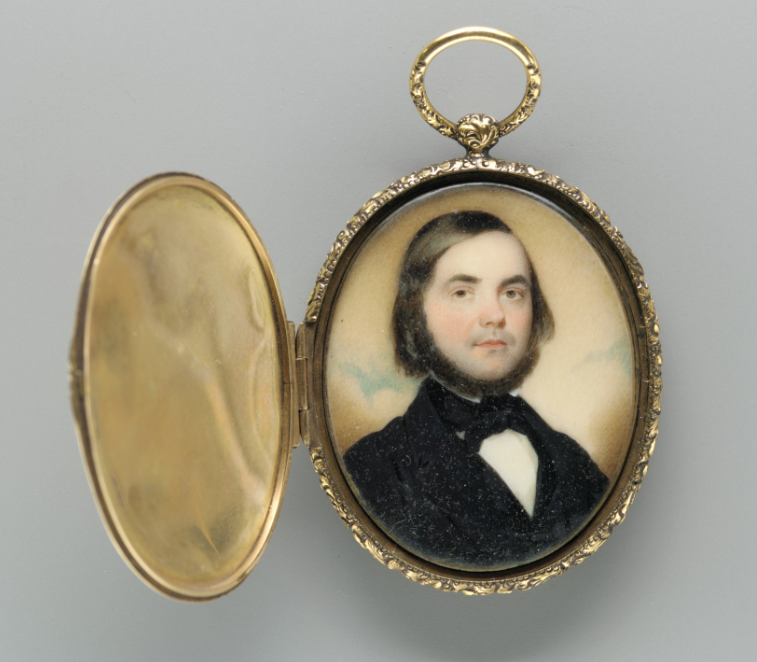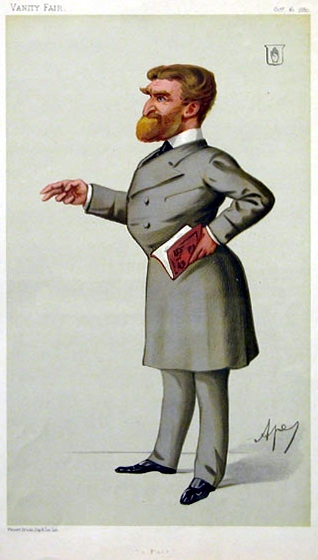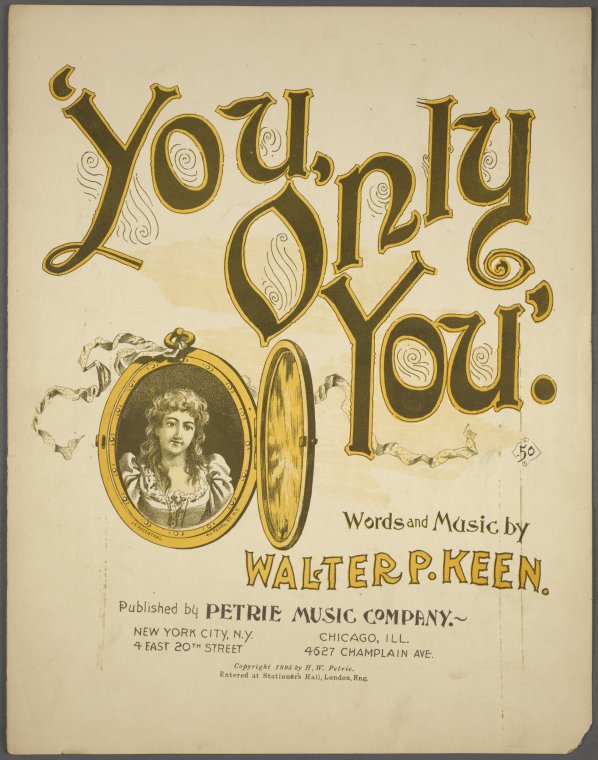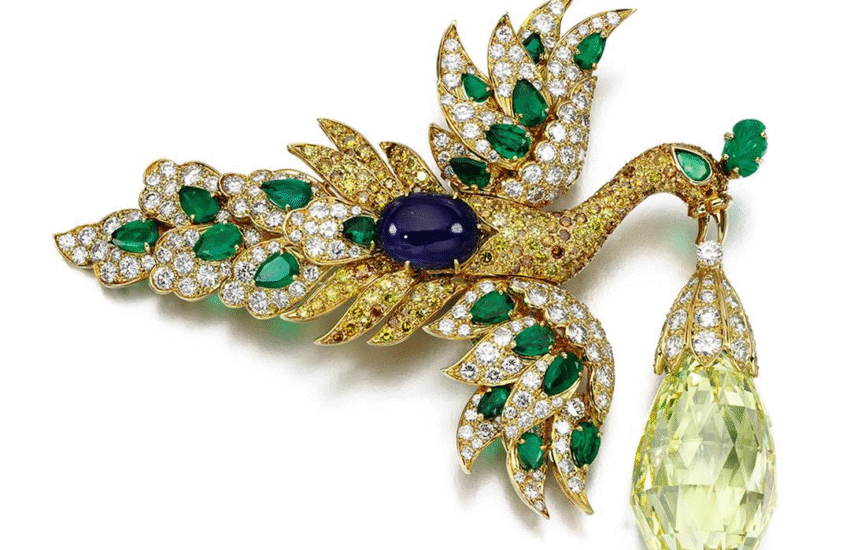Love and Divorce: Betrayed by a locket!
Lockets are jewels of romance and memory. Little containers which hold a picture or lock of hair from your beloved, a way to be kept close to their heart even when you are physically parted. However, sometimes this goes very wrong. I’m going to share a couple of stories here of times when lovers were betrayed by a locket and illicit love led to serious misunderstanding or even divorce… .

In the nineteenth century, divorce was only possible if one party had badly misbehaved or the marriage had never been consummated. If a spouse was cruel or committed adultery, the injured party could ask for a divorce. However, proof was essential and this is where the testament of jewellery gifts can come into play.
An M.P.’s divorce suit

The fantastically bearded gentleman in this caricature from 1880 is Sir John Tollemache Sinclair, 3rd Baronet and Liberal Member of Parliament. His majority of 13 at the 1874 election remains the smallest on record.
The luck which won him an election against the odds seems to have run out when he chose a wife. In 1853, he married Emma Standish of Duxbury Park, Lancashire and the couple had two sons and two daughters. Regrettably, I haven’t yet found a portrait of Emma but she must have had considerable personal charms.
Despite her husband’s skills as a poet and his 80 000 acres of land, all was not well in Emma’s marriage. July 1878 saw their widely reported divorce case, complete with intriguing and salacious details. The case included the sunshine of the south of France and the testimony of romantic gifts, including the fatal locket.
The divorce hearing
According to newspaper reports of the divorce, the couple owned a house in Cannes, in the south of France, where they often spent the winter. On one of these trips, Lady Sinclair began an affair with Henri Audibert, an insurance agent from Toulon. She also became friendly with a M. Lacroix, also an insurance agent. Clearly Emma had a fondness for the profession.
Perhaps showing a degree of pre-medidation, when Emma engaged a new maid, she requested someone very discreet who would not talk about her affairs to anybody. This is not what she got. In fact, Madame Dabaglio, her new maid, seems to have sided entirely with Sir John. Not only did she hand over Emma’s diary, full of incriminating evidence about her affairs, but she also drew his attention to Emma’s personal jewellery. Madame Dabaglio told the court that:
Lady Sinclair showed her a locket with the photograph of Audibert in it. She always wore this locket under her dress and she always wore a ring which bore the inscription ‘Souvenir H.A.
An M.P.’s divorce suit, 5 July 1878
It was rather indiscreet of Emma to wear a ring with the initials of her lover, Henri Audibert. She also stayed with him in hotels under a false name. If this wasn’t bad enough, Audibert had given her a locket, set with his photograph. At least she had the sense to keep this tucked into her dress. But, to no avail. The evidence was overwhelming. Sir John was granted his divorce.
Dear wee Jamie
Emma Sinclair wasn’t the only woman to be caught out with the wrong man’s photograph inside her locket.
In 1870, the Edinburgh manufacturer William Walker sued his wife for divorce on the grounds of adultery. Jane Walker had taken up with a writer, James Grant, the author of ‘The Romance of War’. Clearly he was also the romancer of Edinburgh.
The couple arranged their assignations and left each other sentimental messages through the personal adverts in the Scotsman newspaper. They exchanged secret letters and were spotted cuddling in the grounds of St Cuthbert’s cemetery. Worse still, Mrs Walker sent her servants out on errands so that her ‘dear wee Jamie’ could sneak into the house. Perhaps the encounters in the graveyard were a little drafty and uncomfortable?
The angry husband used the a false note in the newspaper to entrap the couple. Like Emma Sinclair, the romantic locket was one of the clinching pieces of evidence against Jane Walker.
The court was told that:
Mrs Walker had a locket containing Mr Grant’s likeness, which she wore round her neck during the day and kept under her pillow at night.
A Novelist in the Divorce Court, The Cardiff and Merthyr Guardian, 6 August 1870
Although Jane Walker and James Grant claimed that they merely shared a ‘congenial predeliction for romance and sentiment’, the court found her guilty of adultery and ordered the divorce to go ahead. Quite apart from all the other evidence, having a locket with another man’s photograph hidden underneath her pillow was difficult to explain away.
There was an intriguing further development. Jane decided to enter her own plea for divorce against her husband. She claimed that she had recently become aware of his own serial affairs and he was therefore as guilty as she was. Divorce was a serious social shame in the late nineteenth century but it was better for Jane to divorce William than for him to divorce her for adultery. Sadly, either way, she would probably lose custody of any children.
£1000 Divorces
The Jacksons were another couple who parted due to adultery and a tell tale locket. A column in the Cardiff Times, 22 October 1909 reported the unfortunate end to the marriage of Harry Jackson, insurance clerk of Clapham, London and his soon to be ex-wife Lilian.
Did Lilian find the life of an insurance clerk’s wife in Clapham dull?

According to newspape reports, she had taken up with Hubert Knowles Ainsworth, a former officer in the Cape Mounted Rifles and a man of independent means. Ainsworth was not only rich but fun. He took Lilian out to restaurants and to see a show at the London Coliseum.
The Coliseum theatre had opened only a few years previously and was the largest and most technically advanced theatre in the West End. The inaugural show had included a full chariot race on a revolving stage. A far cry from suburban Clapham.
Song sheet for ‘You, only You, by Walter Keen, 1895. New York Public Library
Betrayed by a locket
Matters came to a head when Lilian returned home one evening.
Counsel stated that one night the wife came home late, and on opening her cloak, a locket fell from her neck. It was set with diamonds and contained a man’s portrait. She informed her husband that it was Mr Ainsworth.
Cardiff Times and South Wales Weekly News, Saturday 22 October 1909
This was enough to persuade the court. Not only did Harry Jackson get his divorce but he was also awarded £1000 costs from Hubert Ainsworth, due to the damage to his home life. Perhaps if he had taken Lilian to the theatre and bought her diamond jewellery, things might have been different?
Lockets in fiction
Not only could lockets give away the real-life secrets of illicit lovers but they were a wonderful plot device for the novelist. Lockets could be very private jewels – a commonplace exterior could hide a lock of hair or unexpected portrait.
In the 1882 story of Harold Hyde, a new husband notices a jewelled locket pendant on his bride’s bracelet.
‘What a pretty sparkling thing! How the light flashed in these diamonds just now as you moved your arm. What’s inside? It looks as if it opened.’
‘So it does, but I think the hinge is stiff- it is difficult to open’, Netta answered a little hurriedly.
‘Let me try. But what is inside?’
‘Only a picture. Never mind it, Harold. I don’t think you can open it, dear.’
Despite Netta’s reluctance, Harold insists, joking:
‘A mysterious portrait in a lately-married lady’s bracelet, that has a stiff hinge, and won’t open for the said lady’s too confiding and probably deceived husband? …remember, madam, if you please all the woes that spring from the possession of mysterious miniatures.’
Harold Hyde or The Old House and the New Heir, serialised in the Denbighshire Free Press, 1882
Luckily, Netta’s bracelet doesn’t contain an illicit lover, merely the picture of a female friend who had been previously pursued by Harold. At least for this couple, the portrait hidden inside the locket didn’t spell trouble.

In the story of ‘The two Mrs Ellingtons’, lockets are also used to good effect. When two women meet in a cemetery, they find that they are both wearing a locket with the image of the same man. Both the Mrs John Ellingtons have come to visit the grave of their husband, killed in a railway accident. He had married women on either side of the country, and had it not been for their matching lockets, neither would ever have known.
Ursula, Lady Londesborough, after Sir Francis Grant, British Museum
Damning evidence
A locket set with lock of chestnut hair was a misleading clue in ‘The Lovels of Arden’, a novel from 1871 by Mary Elizabeth Braddon. In this story, the beautiful but poor Clarissa marries Daniel Granger, a kindly older widower. Her head is turned by the flirtation of George Fairfax who seems much more romantic and dashing than her husband. Her husband’s suspicions are aroused. When he goes to find Fairfax, he is shocked to see him wearing a very recognisable jewel. It was a large gold locket with a Maltese diamond cross, which he had given his wife. The reader knows that she had had a lock of her hair set in it and the inscription ‘From Clarissa’ when she gave it to her sister in law Bessie. But her husband, Daniel, leaps to the worst conclusion:
He could never receive his wife again- upon that question there seemed to him no room for doubt…
‘Can any woman be pure, when a man dares ask her to leave her husband!’
And then the locket that man wore -“From Clarissa” – was that not damning evidence?
The Lovels of Arden, Mary Elizabeth Braddon
Luckily, Daniel discovers the true origin of the locket. The couple reconcile and all is well.
Photographs in lockets
These unfaithful women, real and fictional, might have faced less risk of discovery if they hadn’t worn a locket with a photograph of their beloved. Photography became increasingly popular and affordable through the nineteenth century. Photographers developed techniques to miniaturise their prints, small enough to fit into a locket or even a ring.

Adverts like the one placed by the Cardiff photographer R.L. Beard in 1865 offered cartes de visite and ‘highly finished locket portraits’, which could be taken at the sitter’s own house. Infant portraits were available, perhaps particularly appealing at a time of high child mortality. Ladies were advised to avoid wearing blue, mauve and violet patterns which would not show up well in the image.
These photographs brought portraits to a mass audience who could never have afforded the skills of a miniature painter.
Illicit love, divorce and betraying lockets
The divorce reports I’ve looked at show women, bored with their marriages or tempted by a more exciting alternative, who left their respectable lives to embark on daring love affairs. Their lovers gave them lockets set with their photographs – something to tuck under their pillows and kiss in moments of loneliness. But this turned out to be their undoing. Betrayed by the locket and its incriminating photograph, they were dragged through the divorce courts, every detail eagerly reported by newspapers.
Did contemporary writers scour the papers for good ideas? The notion of the love affair betrayed by the wrong face inside the locket or the family secret revealed was one which was widely used. It shows us the secret life of this jewel, not so much worn now but full of potential, good or bad!
More to read
For more stories of love and disappointment found in the newspaper columns, here are the story of the Advertising Widow or the Duke, the heiress and the fake pearls.

